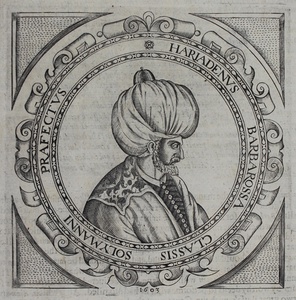| Method | Copper engraving |
| Artist | Lawrence Johnson after Theodor de Bry |
| Published | 1603. [London: Printed by Adam Islip] |
| Dimensions | Image 125 x 125 mm, Plate 132 x 130 mm, Sheet 220 x 160 mm |
| Notes |
An early seventeenth century portrait of Barbarossa, the Ottoman admiral and pirate lord, engraved by Lawrence Johnson for Richard Knolles' The Generall Historie of the Turkes. Like most of the portraits in the series, this plate is a close copy of an earlier portrait engraved by De Bry for Boissard's Vitæ et icones sultanorum turcicorum.' Barbarossa is shown half-length, turned to his left, wearing a very large turban and richly embroidered coat. The Latin inscription in the circular strapwork border describes him as the Prefect of the Fleet of Solomon, a western approximation of his appointment as Kapudan Pasha (Grand Admiral) by Suleiman the Magnificent. Hayreddin Pasha or Khayr ad'Din Barbarus (1478-1546), commonly known in the west as Barbarossa, was the preeminent Ottoman admiral of the sixteenth century, and one of the most successful and famous privateers of all time. Although widely portrayed as a simple pirate by his enemies, notably the Knights of St John and the Spanish Crown, his career was long and politically ambiguous. Hayreddin was born on the Ottoman island of Lesbos to a family of mixed Greek, Turkish, and Albanian ancestry. Although his title, Barbarossa, is generally believed to have derived from his red beard, this is actually a coincidence. His older brother, Oruç, having assisted with the rescue of Muslims from newly reconquered Andalusia, received the honorific title of 'Father,' being hailed as Baba Oruç. This title, transliterated in Spanish and Italian to 'Barbarossa,' passed to Hayreddin upon the death of his older brother at the Spanish siege of Tlemcen. Barbarossa's maritime career began at an early age, while accompanying his brothers on voyages both mercantile and piratical in the eastern Mediterranean. Throughout his career, he captured and sacked many of the islands, forts, and coastal towns of the Mediterranean. In 1516, the brothers captured the city of Algier from the Spanish, where Oruç quickly consolidated power along the North African coast and declared himself Sultan of an independent pirate province. The position was eventually ratified by the Ottoman Sultan Selim I, who incorporated the province of Algeria into the Empire, and tasked the brothers with harrying Christian shipping in the Western Mediterranean. After the death of Oruç, Hayreddin continued to act on behalf of the Ottoman empire from his base of operations in Algier, eventually being elevated to the position of Admiral of the Ottoman fleet. In 1545, Barbarossa retired, dying peacefully a year later in his palace on the coast near Constantinople. Lawrence Johnson (fl.1603) was a British engraver, and one of the earliest native printmakers active in England. He is known principally for engraving the plates for Knolles' Generall Historie of the Turkes, though he also published a very rare portrait of James I. Theodor de Bry (1528-1598) was a Flemish-born engraver and editor, who travelled Europe. De Bry fled from Liège in fear of the Spanish persecution of Protestants, lived in Strasbourg, travelled to Antwerp, then London, and finally settled in Frankfurt-am-Main, where he started a publishing business and printing workshop. Condition: Adhesive staining along left margin of sheet. Latin text above and below plate, and on verso. Sheet trimmed, creased, and chipped at edges, not affecting plate. |
| Framing | unmounted |
| Price | £225.00 |
| Stock ID | 50867 |

